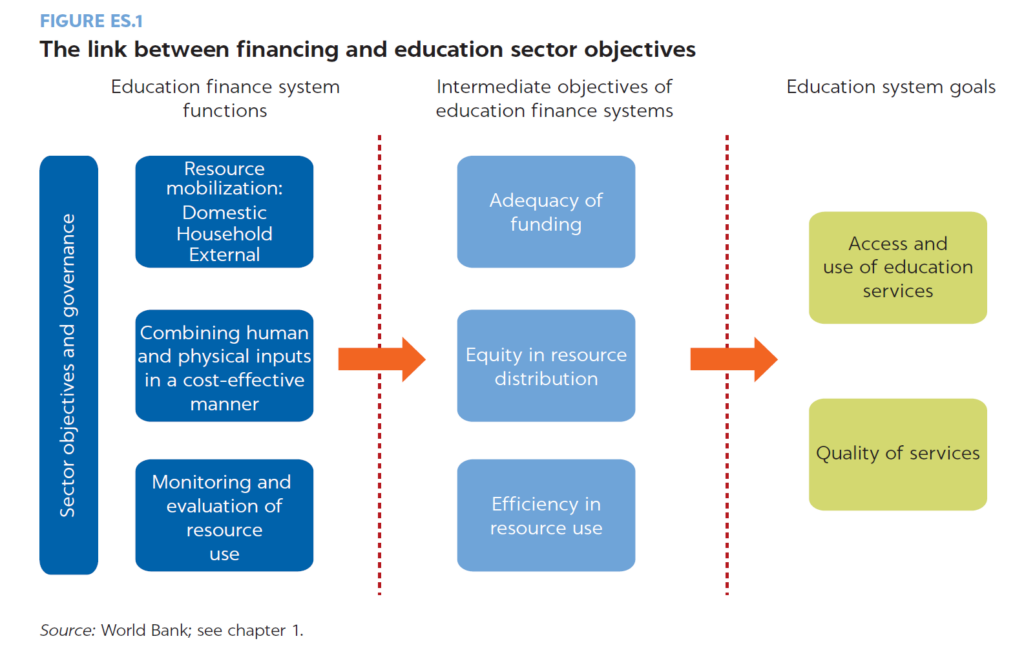
Access to schooling in developing countries has increased rapidly over the last 20 years with many more children, and particularly poor children, starting earlier and staying in school for longer than ever before. These improvements have been due in part to greater investment in education. Global public spending on education has more than doubled in real terms since the early 2000s. The largest increases have been registered in low-income countries where public education spending increased from 3.5 percent of gross domestic product (GDP) in 1998–2001 to 4.1 percent in 2014–17.
Despite increases in investment and improvements in access, many countries continue to face a learning crisis. Across the world, 53 percent of all ten-year-old children are unable to read a short age-appropriate text with comprehension. The proportion of children in learning poverty increases to 90 percent in low-income countries. Changing this picture will require further increases in funding for education. Estimates show that low-income countries would have to increase public education spending to approximately 6 percent of GDP to provide good quality learning opportunities for all. But spending more will not be enough. Research in many countries points to large spending inequalities and inefficiencies that limit the effectiveness of education funding. Addressing the twin financing challenges of inadequate and ineffective spending can support efforts to tackle the learning crisis and contribute to the achievement of national and international education goals (see figure ES.1). The COVID-19 pandemic makes addressing these challenges even more critical to prevent the pandemic’s short-term economic shock from lowering long-term development prospects.
The role of subnational governments in providing basic education services
The vast majority of the world’s children live in countries where subnational governments are responsible for providing basic education services. Over the last 30 years, many countries have introduced reforms to decentralize basic public services. These reforms are expected to improve service delivery outcomes because subnational governments are better placed than central governments to understand what types of services are needed and how best to provide them. Because citizens are closer to their subnational governments, they are also better able to hold them accountable for the services available. Education, and basic education (preprimary, primary and lower secondary schooling) in particular, have been at the forefront of decentralization reforms. Recent estimates indicate that 84 percent of the world’s children live in countries where government primary and secondary schools are run by subnational governments.
Given the central role subnational governments play, the success of efforts to improve education outcomes will depend critically on how they use public funding to tackle the twin financing challenges of adequacy and effectiveness. In countries where education has been decentralized, a large share of public funding is managed and spent by subnational governments. In most countries, subnational governments account for over 50 percent of total public education spending. If the focus is narrowed to basic education only, this share would be significantly higher. For example, subnational governments account for over 80 percent of government spending on primary and secondary education in Uganda. How effectively subnational governments are able to translate these funds into good-quality education services will determine to a large degree the proportion of children in primary and secondary school that leave with the skills they require to continue to learn and lead productive lives.
Although subnational governments manage and make decisions on the use of public education funding, they often rely on transfers from the central government. In decentralized countries, intergovernmental fiscal transfers account for a large share of subnational government revenues. This dependence on transfers extends to subnational education funding. In Sudan, for example, central government fiscal transfers provide states with approximately three-quarters of all public education funding. In Indonesia, two-thirds of all public education funding in 2013 was allocated through fiscal transfers between the central government and provincial and district governments. Beyond core funding, transfer systems can also provide an effective system for channeling funds to protect education systems during times of crisis. For example, in the United States, federal stimulus packages have used existing transfer mechanisms to provide additional financial support to local education systems during the financial and COVID-19 crises.
Assessing the use of fiscal transfers to address education finance challenges
Because transfers account for a large share of subnational spending, the way they are designed and implemented can help address key financing challenges. Most countries use a combination of general- and specific-purpose transfers to support subnational governments’ delivery of education services. General-purpose transfers are unconditional fiscal transfers that subnational governments may allocate across their responsibilities, including education, according to their own preferences and needs. Central governments often complement these general transfers with conditional or specific-purpose transfers. These transfers to subnational governments are targeted for use in particular sectors and relate to providing certain inputs or are tied to improvements in sector-specific outputs or outcomes.
A recent World Bank report on the role of conditional grants in financing education (edited by Samer Al-Samarrai and Blane Lewis) consists of seven country case studies that explore how fiscal transfers affect education sector financing and ultimately sector outcomes. Country case studies were conducted in Sudan, Uganda, Indonesia, Colombia, Brazil, Bulgaria, and China. The selection of case studies was driven primarily by the need to cover a broad set of country experiences and to capture countries at different stages of economic development and decentralization. As a result, the case studies provide a broad set of examples of how fiscal transfers have been used to address education sector challenges at different stages of development.
Challenge 1: Providing adequate resources for education (the vertical allocation of education resources)
Transfers can play a critical role in helping subnational governments adequately fund the services for which they are responsible, including the provision of basic education. Although all transfers provide subnational governments with additional resources, they do not automatically result in higher spending on education. General purpose (e.g., unconditional or equalization) transfers increase the overall amount of revenue available, but subnational governments can, and often do, choose to use these funds on other overall spending on education because fiscal resources are fungible.
The evidence from the case studies generally shows that intergovernmental fiscal transfers are successful at increasing subnational spending on education. The analysis in the case studies show that the receipt of general- and specific-purpose transfers resulted in subnational governments spending more on education, although specific-purpose transfers often had a larger effect. For example, in Brazil and China, the estimated marginal effect for education-specific conditional transfers was higher than that for unconditional transfers. However, differences in the effect of general- and specific-purpose transfers on subnational education spending is likely to be dependent, to an extent, on their relative size. For example, specific-purpose transfers had a greater effect on subnational spending in Brazil, where these transfers made up approximately 62 percent of municipal spending, than in Indonesia, where they accounted for only 11 percent.
Although transfers generally increase public education spending, only a few countries use the transfer system to ensure that all subnational governments have adequate funds for education. Some countries have designed specific-purpose transfers that are based on the actual costs associated with providing education to each student. These schemes are distinctive because they provide guaranteed and predictable funding for education that is insulated, to a large degree, from government budget fluctuations. For example, in Bulgaria, the central government uses a unified per student cost standard to allocate specific-purpose funds for municipally owned schools. Other countries have designed transfers so as to guarantee an annual minimum level of per student funding. For example, in Brazil, federal funds for education are allocated in a way that ensures a minimum level of per student funding in all states based on a set of specific annual revenues.
Challenge 2: Encouraging more equitable and efficient horizontal allocation of public funding for education
Improving equity. Education spending inequalities between subnational governments can be large. In Sudan, the state with the highest funding per student spends approximately 21 times the amount spent in the state with the lowest funding levels. These subnational spending inequalities frequently reinforce patterns of poverty between subnational governments. World Bank public expenditure reviews and other studies have shown that, in approximately one-half of developing countries with available data, there was a negative and statistically significant relationship between subnational poverty rates and education spending (meaning that local jurisdictions with higher levels of poverty receive less grant support from the central government). A similar pattern was found in some of the case studies, including Sudan and Uganda. There are relatively few countries that show an opposite and statistically significant relationship.
“…in approximately one-half of developing countries with available data, there was a negative and statistically significant relationship between subnational poverty rates and education spending… There are relatively few countries that show an opposite and statistically significant relationship…”
Because transfers can fund a large share of subnational education spending, the way in which they are distributed is critical to improving spending equity between subnational governments. Addressing horizontal imbalances in revenue between subnational governments is a major objective of most fiscal transfer systems. Most of the case study countries have general-purpose transfers that are designed to reduce inequalities of this kind across the whole set of subnational responsibilities. For example, in China, equalization general-purpose transfers make up approximately two-thirds of all transfers to provinces and counties. These transfers are allocated according to formulas that include estimates of subnational fiscal gaps, which measure the gaps between subnational revenues and expenditure obligations, as well as population size and levels of economic development. Most of the case study countries also have specific-purpose transfers that aim to narrow inequalities in subnational spending on education.
Achieving an efficient horizontal allocation of resources. The horizontal allocation of fiscal transfers is not just about fairness, but also about making sure resources are distributed in a way that achieves efficiency in the way public education is funded. Carefully designed transfers can increase spending efficiency in education. In the early 1990s, the education systems in many countries in Europe and Central Asia were becoming more inefficient as a result of declines and changes in the school-age population. These demographic shifts often resulted in the existence of many small schools, small class sizes, and low student-teacher ratios. Moreover, the existing input-based funding mechanisms were giving municipalities and schools no incentives to adjust to the new reality. Per capita financing mechanisms were introduced that linked transfer allocations to student numbers. Municipalities could no longer afford to fund their existing school networks, which gave them an incentive to find ways to increase spending efficiency.
At the same time, the design and implementation of fiscal transfers can sometimes drive inefficiencies in public education spending. For example, in Indonesia, the formula for the largest general transfers includes incentives for district governments to spend more on hiring civil servants than on non-salary spending. In education, this has resulted in a tendency to hire more teachers than is required to comply with minimum service standards and maximum class sizes and is an important driver of inefficiency.
Strengthening the link between spending and sector results (transforming financial inputs into outputs and outcomes at the local level)
Fiscal transfers can create incentives for subnational governments to expand access to education services and improve learning. As the country case studies and other research have shown, intergovernmental fiscal transfers increase subnational education spending, and this additional funding has the potential not only to increase access to education but also to improve learning outcomes. Econometric analysis in the case studies in Brazil, Colombia, Indonesia, and Uganda shows that both transfers and subnational education spending have a positive and significant impact on student achievement. For example, in the Indonesia case study, a 10 percent increase in subnational per capita education spending increased students’ test scores by 0.6 percent. Although the relationship is significant, it is not very strong, and there is considerable variation in the effectiveness of subnational entities in translating funding into outcomes. In an effort to strengthen the link between funding and outcomes, fiscal transfers in some countries, particularly specific-purpose transfers, have been designed to include stronger incentives for subnational governments to focus on improving the performance of schools and students.
Transfers can be designed to provide direct incentives to encourage subnational governments to expand education access. In particular, transfers that include a per student allocation can act as a strong incentive for subnational governments to enroll more students. When education transfers include a per student element, subnational governments know that if they expand access, they will receive funding from the central government to help cover the costs of providing more school places. This has had the effect of reducing the cost burden on subnational governments and, in turn, on households, while also narrowing inequalities in access to basic education. Many countries use these types of transfers to encourage and sustain widespread access to basic education.
In some countries, the transfer system has also aimed to incentivize improvements in education quality and student learning outcomes. Compared with transfers that support increasing access to schooling, there is less evidence available on the effectiveness of performance-based transfers that focus on learning outcomes, particularly in developing countries. However, recent evidence from the use of performance-based transfers in the state of Ceará in Brazil show that they can be an effective tool to improve performance.
Although performance-based grants can lead to better education outcomes, their effectiveness depends on solid and comprehensive information systems, good implementation capabilities of subnational governments, and careful design to avoid any negative consequences such as the risk of transfers of this kind widening existing inequalities. When these preconditions cannot be met, more rudimentary conditional grant mechanisms may still ensure more efficient and equitable funding of local education services.
Access the entire book from the World Bank website:
Samer Al-Samarrai and Blane Lewis. 2021. https://openknowledge.worldbank.org/handle/10986/35838





